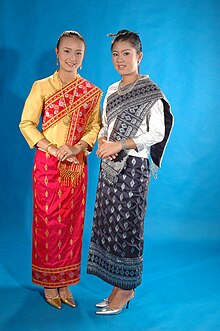| This article needs additional citations for verification. Please help improve this article by adding citations to reliable sources. Unsourced material may be challenged and removed. Find sources: "Sinh" clothing – news · newspapers · books · scholar · JSTOR (February 2016) (Learn how and when to remove this message) |

The Sinh (Lao: ສິ້ນ, [sȉn]; Thai: ซิ่น, RTGS: sin, [sîn]; Tai Nuea: ᥔᥤᥢᥲ; Northeastern Thai: สิ้น, [sìn]), or commonly (Thai: ผ้าซิ่น, RTGS: pha sin), is a handmade traditional skirt, often made of silk, that are worn by Lao women and Thai women, particularly northern Thai and northeastern Thai women. It is a tube skirt. Its pattern can indicate which region the wearer is from. In present-day Thailand, pha sins are typically worn at special events. However, in Laos, Sinhs are worn more regularly in daily life.
Components

A sinh is typically composed of three components:
- hua sinh (Lao: ຫົວສິ້ນ), literally 'the head of the sinh', is the waistband portion, which is typically tucked in and hidden.
- phuen sinh (Lao: ພື້ນສິ້ນ) or tua sinh (Thai: ตัวซิ่น), literally 'the body of the sinh', is the body of the sinh. This part of the sinh is typically not detailed. In particular, it typically only consists of one or two colors.
- tin sinh (Lao: ຕີນສິ້ນ), literally 'the foot of the sinh', is the hem. The hem is typically woven with a lot of details. The specific details of the hem can indicate where the sinh is made.
Textiles
The sinh is made of silk or handwoven cotton. They come in different textures and designs, frequently created in rural areas. Premium silk versions may go for over 50,000 baht per piece, particularly if created by a well-known traditional weaver. Less expensive fabrics cost about 3,000 baht.
Gallery
-
 Princess Thip Keson (or Thep Kraison), Princess of Chiang Mai, consort of Inthawichayanon of Chiang Mai and mother of Dara Rasmi wearing sinh and pha biang, before 1884
Princess Thip Keson (or Thep Kraison), Princess of Chiang Mai, consort of Inthawichayanon of Chiang Mai and mother of Dara Rasmi wearing sinh and pha biang, before 1884
-
 Thai girl wearing Isan style sinh
Thai girl wearing Isan style sinh
-
 Thai girls wearing northern Thai sinhs
Thai girls wearing northern Thai sinhs
-
 Lao women wearing sinhs
Lao women wearing sinhs
-
 Lao women wearing sinhs
Lao women wearing sinhs
See also
References
- ^ Thepthong, Phitsanu (17 February 2020). "Pushing 'phasin' to the fore". Bangkok Post. Retrieved 18 February 2020.
- Laoconnection.com. "Laoconnection.com". Laoconnection.com. Retrieved 2021-08-11.
- "Thai Traditional Dress" (PDF). SALC Newsletter. 84. Chulalongkorn University Language Institute: 5–8. March 2018. Retrieved 18 February 2020.
Further reading
- Dolly Brittan (1997). The People of Laos. New York: PowerKids Press. ISBN 082-3951-24-3.
- Edeltraud Tagwerker (2009). Siho and Naga--Lao Textiles: Reflecting a People's Tradition and Change. Frankfurt am Main: Peter Lang. ISBN 978-363-1586-89-1.
External links
- Sinhs (Lao skirt fabric)
- Why Must Lao Girls Wear A Sinh To University
- Lao Identity Archived 2014-07-09 at the Wayback Machine
| Clothing | |||||||||
|---|---|---|---|---|---|---|---|---|---|
| Headwear | |||||||||
| Neckwear | |||||||||
| Underwear and lingerie |
| ||||||||
| Tops | |||||||||
| Bottoms |
| ||||||||
| Full-Body Wear |
| ||||||||
| Coats and outerwear |
| ||||||||
| Nightwear | |||||||||
| Swimwear | |||||||||
| Legwear | |||||||||
| Footwear | |||||||||
| Accessories |
| ||||||||
| Dress codes |
| ||||||||
| Related | |||||||||
| Folk costumes | |||||||||||||
|---|---|---|---|---|---|---|---|---|---|---|---|---|---|
| Africa | |||||||||||||
| Asia |
| ||||||||||||
| Europe |
| ||||||||||||
| South America | |||||||||||||
| North America | |||||||||||||
| Oceania | |||||||||||||
